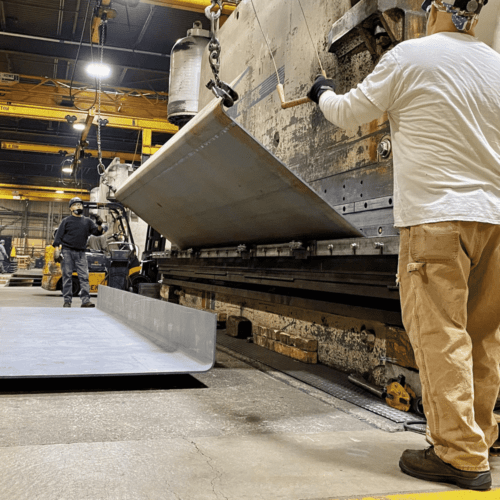Press Brake Forming vs. Roll Forming
If you request a piece of metal to be bent, rolled, or otherwise formed by a metal fabricator, it likely will go through a Press Brake, or a roll forming machine at some point. Each of these machines is capable of bending metal into a desired shape, and at first glance, the two might seem to be more similar than they are different. However, when you explore the two techniques and machines further, you’ll come to realize that the two have different properties, characteristics, benefits, and applications.
How, then, do you decide which technique is best equipped to handle your next metal forming project? In this blog post, we’ll dive into the similarities and differences between roll forming and press brake forming.
Press Brake Forming

Properties and Characteristics
From small and intricate to large and powerful, press brakes come in a variety of sizes. Most commonly, press brakes perform a method called air bending, which is where the metal being formed is punched down into the frame without making contact with it. This method produces a rounded cross-section on both sides of the bend. For crisp, sharper edges the metal can be forced into contact with the crease of the frame (called coining or bottom bending, depending on how exact you want the bend to be), often resulting in a tighter radius bend.
Benefits
Press brake forming is ideal for low- to medium-volume orders, especially orders requesting smaller and shorter components. When performed in the right conditions, press brake forming is one of the most, cost-effective metal forming techniques. It is capable of bending metal at almost any orientation or position; its limitation being that there must be ample room for the metal being bent to fit inside and around the press brake. There’s also a limit to the sheet size and length of the bend.
Press brake tooling can be simple to set up, depending on the configuration, which can help save both time and money. Additionally, after the components are formed using the press brake, they can easily be moved to other departments to undergo additional operations or steps in the fabrication process.
Applications
Press brakes can be used to create a wide variety of components. Common applications include component parts for industries such as: agriculture, construction, mining, defense, energy, trailers/truck bodies, contract manufacturing, and others.
Roll Forming
As its name implies, roll forming is a continuous metal forming technique that uses pairs of rollers to shape a piece of metal as it passes through the machine.
Properties and Characteristics
Roll forming can be a complex and time-consuming technique, in that it requires significant setup time and tooling. It is well suited to handle long production runs, specifically when identical components are being fabricated. If a different component needs to be fabricated, a new roller layout is required, and each of the rollers (of which there could be as many as ten or more) will have to be calibrated and retested to ensure that the machine will produce the desired result.
Benefits
Since the machine and its rollers can be uniquely configured, roll forming is a versatile technique that allows for additional metal forming processes, such as punching and notching, to be performed on the component as it works its way through the machine.
Applications
Roll forming can be used to produce a variety of cross-section profiles, the most common of which is an open profile, although tube-like shapes can be fabricated as well. Roll-formed metal components are typically found in long, thin forms, such as support rails, guard rails, gutters, and more.
Press Brake Forming services from G.E. Mathis Company
At G.E. Mathis Company, we have eight (8) hydraulic press brakes capable of handling almost any project, regardless of size, volume, or complexity. Our press brakes include both manually operated and CNC-controlled, which can handle up to a 1,000 ton capacity, and can produce parts up to 48 FT in length. Located in Chicago, our modern facility and qualified staff are more than capable of delivering on founder George E. Mathis’s core values of quality, integrity, and craftsmanship.
In addition to being an ISO 9001:2015-certified manufacturer, G.E. Mathis Company can provide the following services:
- PPAP (Production Part Approval Process) – All Levels
- FAIR (First Article Inspection Report)
- Capability Studies (Statistical Process Control)
- CMRT (Conflict Minerals Reporting Template)
To get specifics for a project estimate, request a quote today. For all other information, including more information on our available press brakes and press brake forming services, please contact us today.













